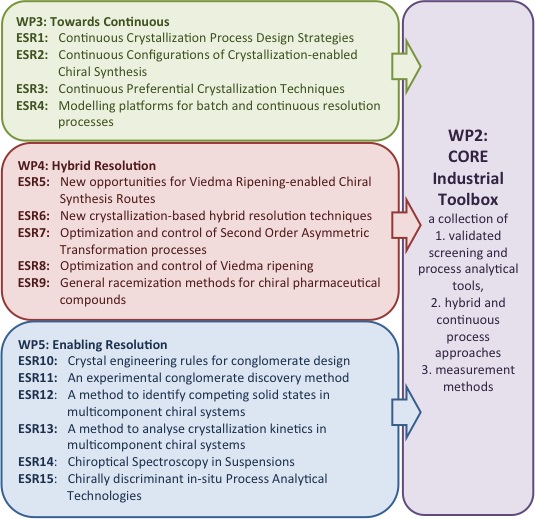research work packages

Work Package 3 – Towards Continuous
This WP will translate conventional batch resolution processes to continuous configurations. The approach consists of developing general design rules for continuous processes (T3.1), developing continuous configurations of crystallization-based chiral synthesis (T3.2) and developing optimized continuous versions of preferential crystallization and Viedma Ripening (T3.3). The 3 tasks are integrated by the ESR’s joint construction and application of process models for all types of continuous resolution.
Update from CORE newsletter Issue 2 - October 2019
With three published papers and more in the making, Work Package 3 is proceeding well towards the goal of continuous resolution of chiral conglomerate-forming compounds and of racemic compound-forming systems at the eutectic. Process simulations and experimental work based on either preferential crystallization and temperature cycling have been the main routes investigated. Clopidogrel, one of the model compounds of interest, has also been used to face these challenges.
Update from CORE newsletter Issue 1 - February 2019
The main task of WP3 is to deliver rules of continuous resolution processes crystallization based. Preferential Crystallization and Viedma Ripening are the principal techniques on which the WP works. They allow forming homochiral crystals starting from a racemic mixture of the two enantiomers using a very small amount of seeds of the target enantiomer. While, so far, these processes have been developed and successfully applied in batch reactors, making continuous process configurations is challenging for a number of areas. The WP combines process modelling and experiments in a joint effort among ESRs 1 to 4.
Work Package 4 – Hybrid Resolution
This WP will focus on hybrid resolution processes combining racemization and crystallization. The first task is to enlarge the application area of crystallization-enabled chiral synthesis (T4.1). Additionally, the crystallization processes relevant in Viedma Ripening and Second Order Asymmetric Transformation (SOAT) will be optimized (T4.2). The third task is to extend the application area of Viedma Ripening and SOAT by increasing the library of racemization reactions to include new chiral centers (T4.3). Through secondments and network events the ESR project results will be exchanged and applied throughout the different tasks.Update from CORE newsletter Issue 2 - October 2019
The development of new racemization routes as well as the optimization of process parameters are the main topics covered by Work Package 4. Racemization represents sometimes a bottleneck for Viedma ripening, temperature cycling and second order asymmetric transformation (SOAT), which are the processes studied in this WP. As of now, eight papers have been published and more will soon be submitted. Praziquantel (another model compound suggested to the CORE network) together with Clopidogrel are currently being used by some of the ESRs of this WP.
Update from CORE newsletter Issue 1 - February 2019
The work package 4 focuses on hybrid resolution processes combining racemization and crystallization. Since racemization is a real bottleneck for the Viedma ripening process, an important part of the WP4 aims to explore the applicability of several racemization routes such as photoracemization, high temperature-based racemization and acid-base racemization. Besides that, the optimization of the process steps and parameters covers another big area of interest. ESRs 5 to 9 work in a joint effort to try to find answers to the problems arising from these challenges.
Work Package 5 – Enabling Resolution
The WP focusses on enabling resolution through 3 approaches. To enable resolution, a conglomerate is preferred (T5.1), crystallization behaviour should be known (T5.2) and it should be possible to monitor the resolution process (T5.3).Update from CORE newsletter Issue 2 - October 2019
ESRs of Work Package 5 are currently working on different tasks covering i) co-crystal predictions and analysis for new conglomerate-forming systems; ii) conglomerate detection using second harmonic generation (SHG); iii) resolution of racemic systems through their stable/metastable conglomerate and of conglomerate co-crystals by means of preferential crystallization processes and iv) development of Process Analytical Tools (PAT) for online monitoring of resolution processes. Three publications by this WP are now available and more have been submitted/ will soon be submitted.
Update from CORE newsletter Issue 1 - February 2019
The Work Package 5 bases its research on five tasks: i) development of an enhanced cocrystallization rules using networks to explore new MCS conglomerate possibilities; ii) development of a new device for detecting conglomerates using SHG-Analysis; iii) resolution of racemic systems through their stable/metastable conglomerate by means of preferential crystallization process; iv) development of PAT technique for online monitoring of the resolution process; v) automated sampling setup to validate the chiral application and utilization of developed devices in relevant industries. ESRs 10 to 15 are involved in this work package.